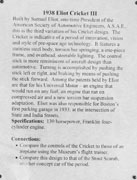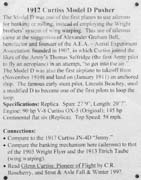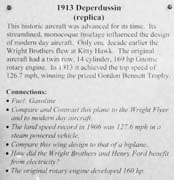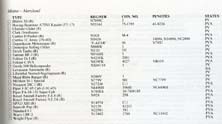
What this display entails hardly needs explaining: Kitty Hawk is frequently cited as the location of the Wright brothers' first controlled, powered airplane flights on 07Dec1903, but the flights actually occurred in what is now Kill Devil Hills.. See Wikipedia.

The Clark Ornithopter was built in Pennsylvania in about 1900; the current engine, a 5 hp Waterman air cooled two cylinder, was fitted in 1907. Testing of the design finished in 1910 but it is believed that it never actually left the ground...


Etrich Taube (1913).
Igo Etrich studied Lilienthal's gliders, bird wings, and flying foxes before deciding to model his airplanes's wings after the zazonia tree seedpod from Java, based on a theory held by Dr. Friedrich Ahlborn, a German botanist, that dried zazonia seed was the perfect aerodynamic form.
For more information click below thumbnail.



Farman III (1910)
Henri Farman's introduction into aviation was in 1907, flying an aircraft built by the Voisin brothers of France. Within months, Farman began modifying the Voisin craft. In november of that year, Farman won the Archdeacon Cup for the first official flight of more than 150 meters by flying 1.030 meters in 1 minute and 14 seconds!



The Standard J was a substitute standard basic trainer aircraft produced in the USA from 1916-18. It was a 2-seat tandem biplane constructed from wood with wire bracing and fabric covering.
More information through the thumbnail below or Wikipedia.


Royal Aircraft Factory F.E.8 (1916)
The F.E. 8 was a unique British fighter built by the Royal Aircraft Factory in the early stages of World War 1.
A rear-mounted engine was used to prevent the bullets from a forward-firing
gun from hitting the propellor - a serious problem until the perfection of the gun synchronizer.



The Curtiss JN-4 'Jenny' was one of a series of 'JN'- biplanes, built by the Curtiss Aeroplane Company of Hammondsport, New York, later the Curtiss Aeroplane and Motor Company. Although the Curtiss JN series (the common nickname was derived from 'JN') was originally produced as a training aircraft for the U.S. Army, the 'Jenny' continued post-World War I as a civil aircraft to become the backbone of American post-war (civil) aviation.
More information through the thumbnail below or Wikipedia.



Stearman-Boeing A75N1 Kaydet (1941)
The Stearman was AMerica's leading primary trainer of World War 2, ovefr 10.000 aircraft were built for the US Navy and Army Airforce. Dating back to 1933 in basic design, the Kaydet was built in greater quantities than any other American or European biplane.



Nieuport 28 C.1 (1917)
Originally rejected as first line equipment by the French Air Service, the Nieuport 28 C.1 was supplied to the 1st Pursuit Squadrons of American expeditionary forces in early 1918, due lack of more suitable aircraft.



Spad XIII C.1 (1917)
The SPAD S.XIII was a French biplane fighter aircraft of World War I, developed by Société Pour L'Aviation et ses Dérivés (SPAD) from the earlier highly successful SPAD S.VII. It was one of the most capable fighters of the war, and one of the most-produced, with 8,472 built. (-Wikipedia)


A 2015 update showed a much changed livery; see Terry Fletcher's images on Photos by Friends & Guests (44)

Fokker DR.I (1917)
The DR.I was designed by Reinhold Platz, from brief descriptions by Anthony Fokker, who had seen a Sopwith Triplane in action. Although the DR.I was not a fast plane, it proved to be remarkably maneuverable. Manfred von Richthoven, a.k.a. the Red Baron, flew the DR.1 in the last 21 of his record setting 80 aerial combat victories



Eliot Cricket III (1938)
No, not a plane, but remarkable in a comic way!
Samuel Eliot, ASAE, was an automotive experimenter and visionary. The Cricket III incorporated many of his ahead-of-the-time ideas; torsion-bar suspension, stainless-steel body; one-piece frame, rear-mounted engine, aircraft type control column for steering and braking and no-glare, slotted headlights. Among his many patents was an engine which would run on any fuel.


Curtiss Model D Pusher (1912)
The Model D was one of the first planes to use ailerons for banking and rolling, instead of employing the Wright brothers' system of wing warping. This use of ailerons came at the suggestion of Alexander Graham Bell.


Deperdussin
(1913, replica)
The Deperdussin Monocoque was an early aircraft built in 1912 by the Société Pour les Appareils Deperdussin, commonly abbreviated "SPAD". Designed as a racing aircraft, it was a single-seated monoplane with a streamlined shape. The Deperdussin Monocoque proved very successful in competition, it won the Gordon Bennett Trophy. (Wikipedia)



